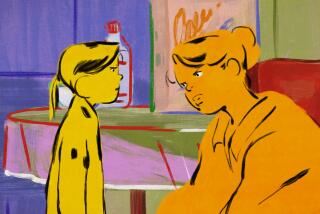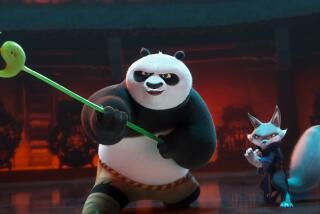Television review: ‘Kung Fu Panda: Legends of Awesomeness’
- Share via
“Kung Fu Panda” was one of those movies you had to see to believe. At least to believe it was any good.
The concept — a bumbling out-of-shape Panda named Po (voiced by Jack Black) finds himself living his dreams when fate decrees he join the Kung Fu elite of Tigress (Angelina Jolie), Mantis (Seth Rogen), Crane (David Cross), Monkey (Jackie Chan) and Viper (Lucy Liu) and overseen by the diminutive but mighty Master Shifu (Dustin Hoffman) — seemed pretty silly, designed to sell stuffed panda dolls more than anything else.
But once the zen kicked in and you accepted the idea of a praying mantis and a crane as mighty warriors, the story took on epic dimensions. Having been surprisingly declared the Dragon Warrior, Po must learn the skills that befit his title so to claim the magic talisman (the Dragon’s scroll) and fight the Enemy — a turncoat warrior named Tai Lung (Ian McShane). It’s a classic hero’s journey, only this time the protagonist was neither hobbit nor wizard but a panda, soft, squishy and funny as Jack Black.
It was a huge hit and spawned, inevitably, a sequel, “Kung Fu Panda 2,” which debuted at Cannes and is, thus far, the No. 1 animated film, and the 12th highest-grossing film of this year. There have been two follow-up videos (“The Secrets of the Furious Five” and “Secrets of the Masters”) and a holiday special that ran on NBC.
Not surprisingly, there is now a television series, “Kung Fu Panda: Legends of Awesomeness,” which debuts Monday night on Nickelodeon. Obviously, the cast is a few letters over from A-list — only Liu remains of the original Furious Five. Po is now voiced by Mick Wingert, Tigress by Kari Wahlgren, Crane by Amir Talai, Mantis by Max Koch, Monkey by James Sie and Shifu by Fred Tatasciore.
Although it is unfair to compare the voice talents of the casts, it is impossible not to, and with the exception of Wingert, who does capture the plumy awesomeness of Black’s Po with astonishing accuracy, everyone else is a milder, flatter version of the original. As is the animation and the writing. But that is not surprising — although the films are much more expensive and therefore aimed at a broader audience, the show is aimed at kids and perhaps those on the lower edge to tweendom, and within those parameters, it works just fine.
Better than fine, actually. The pilot opens with a slyly sophisticated bit about Mantis having broken up with his girlfriend — a caterpillar who turned into a butterfly. (“Suddenly, it was like I didn’t know her.”) To comfort him, Po makes his “famous” sticky dumplings, which, through a series of unfortunate events, manage to all but destroy the machinery of the kung fu training center. Po finds one of the original architects, a rhino voiced by Wallace Shawn, and asks him to fix things. What could be an “I Love Lucy” skit with talking animals instead turns into “Lord of the Rings,” as the evils of technology faces off against the purity of kung fu.
“Kung Fu Panda” is one of the few shows that has a certain level of diversity built in, not to mention the promising travelogue aspect of introducing children to China. More important, at least for any adults in the vicinity, none of the characters or voices is intentionally annoying, because this is kung fu, and it’s all about finding your center, creating power from calm.
One can only hope that the characters are cute enough and the action lively enough to distract children from the lack of nasal tones and maddening laughter or repetitive catch phrases that have become prerequisites for animated shows (thank you, SpongeBob). Because “Kung Fu Panda: Legends of Awesomeness” may be aimed at a younger and smaller demographic than its cinematic antecedents, it is, mercifully, a show that won’t drive every adult in earshot absolutely crazy. And these days, that’s saying something.
More to Read
The complete guide to home viewing
Get Screen Gab for everything about the TV shows and streaming movies everyone’s talking about.
You may occasionally receive promotional content from the Los Angeles Times.







